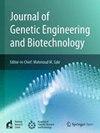混合香料对心肌梗死损伤的心脏保护作用:体内和计算机研究
IF 2.8
Q3 Biochemistry, Genetics and Molecular Biology
Journal of Genetic Engineering and Biotechnology
Pub Date : 2025-04-19
DOI:10.1016/j.jgeb.2025.100492
引用次数: 0
摘要
心肌梗塞是由动脉阻塞引起的心脏组织永久性坏死。它会导致氧气和营养的输送不足,导致患处的肌肉损伤。在这里,混合香料——洋葱、大蒜、生姜、红辣椒、姜黄、小茴香籽、香菜、小豆蔻、黑胡椒、丁香、胡芦巴、黑草、肉桂和小茴香籽——的水提取物被制备出来,以评估白化大鼠的心脏保护功能。为了系统观察异丙肾上腺素对白化大鼠心肌损伤的保护作用。大鼠每日口服提取液(200 mg/kg体重)28天,第29天和第30天滴注异丙肾上腺素(100 mg/kg体重)。通过心肌肥厚、组织病理学和qRT-PCR分析Caspase-3 mRNA表达,可明显改善大鼠的心脏损伤。利用化学信息学工具对印度药用植物、植物化学和治疗学(IMPPAT)数据库中820种混合香料天然化合物与CASP-3蛋白的相互作用进行筛选,发现百里对苯二酚、4-异丙基苯甲酸和1-萘基乙酸的结合能分别为- 6.112 kcal/mol、- 6.206 kcal/mol和- 6.112 kcal/mol,是最佳配体。值得注意的是,胸腺对苯二酚表现出最低的预测细胞毒性。此外,通过分子动力学模拟验证了与CID-6167(对照)相比,胸腺对苯二酚与CASP-3蛋白结合的稳定性。因此,本研究探讨了混合香料对大鼠的心脏保护作用,并确定了胸腺对苯二酚是抗CASP-3的天然先导化合物,为心肌损伤药物治疗的发展铺平了道路。本文章由计算机程序翻译,如有差异,请以英文原文为准。

Cardioprotective function of mixed spices against myocardial infarction injury: In-vivo and in-silico study
Myocardial infarction is the permanent necrosis of heart tissue caused by an artery obstruction. It causes an inadequate delivery of oxygen and nutrients, resulting in muscle injury in the afflicted areas. Here, water extract of mixed spices—onion, garlic, ginger, red chili, turmeric, cumin seed, coriander, cardamom, black pepper, cloves, fenugreek, nigella, cinnamon, and carom seed—was prepared to evaluate cardioprotective function in albino rats. To systematically investigate cardioprotective efficacy, isoproterenol was injected into albino rats to induce myocardial injury. The prepared extract was administrated orally to rats daily for 28 days (200 mg/kg body weight) before infusion of isoproterenol (100 mg/kg body weight) on 29th and 30th days. The induced cardiac injury was significantly ameliorated in rats based on cardiac hypertrophy, histopathology, and Caspase-3 mRNA expression analysis by qRT-PCR. The Indian Medicinal Plants, Phytochemistry And Therapeutics (IMPPAT) chemical database of 820 natural compounds from the mixed spices was then screened against CASP-3 protein using cheminformatics tools, where thymohydroquinone, 4-isopropylbenzoic acid, and 1-naphthylacetic acid were found to be the best interacting ligands, with binding energy scores of −6.112 kcal/mol, −6.206 kcal/mol, and −6.112 kcal/mol, respectively. Notably, thymohydroquinone exhibited the lowest predicted cytotoxicity. Furthermore, molecular dynamic simulation was used to validate the binding stability of the thymohydroquinone with CASP-3 protein compared to CID-6167 (control). Thus, this study explored that mixed spices have cardioprotective effects in rats and identified thymohydroquinone as a natural lead compound against CASP-3, which may pave the way for the development of pharmacotherapy for myocardial damage.
求助全文
通过发布文献求助,成功后即可免费获取论文全文。
去求助
来源期刊

Journal of Genetic Engineering and Biotechnology
Biochemistry, Genetics and Molecular Biology-Biotechnology
CiteScore
5.70
自引率
5.70%
发文量
159
审稿时长
16 weeks
期刊介绍:
Journal of genetic engineering and biotechnology is devoted to rapid publication of full-length research papers that leads to significant contribution in advancing knowledge in genetic engineering and biotechnology and provide novel perspectives in this research area. JGEB includes all major themes related to genetic engineering and recombinant DNA. The area of interest of JGEB includes but not restricted to: •Plant genetics •Animal genetics •Bacterial enzymes •Agricultural Biotechnology, •Biochemistry, •Biophysics, •Bioinformatics, •Environmental Biotechnology, •Industrial Biotechnology, •Microbial biotechnology, •Medical Biotechnology, •Bioenergy, Biosafety, •Biosecurity, •Bioethics, •GMOS, •Genomic, •Proteomic JGEB accepts
 求助内容:
求助内容: 应助结果提醒方式:
应助结果提醒方式:


